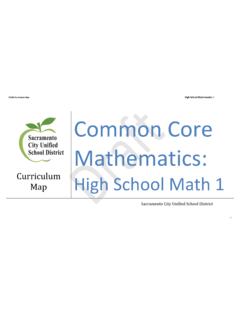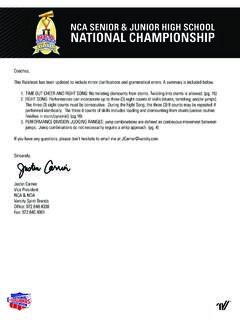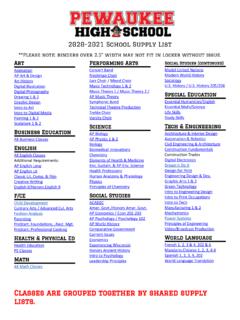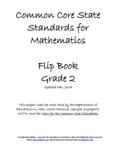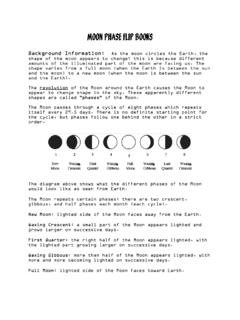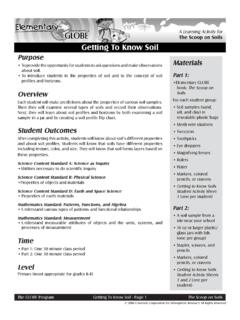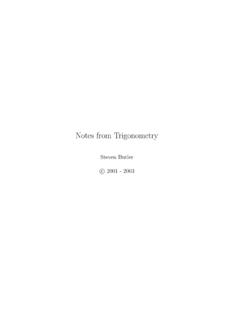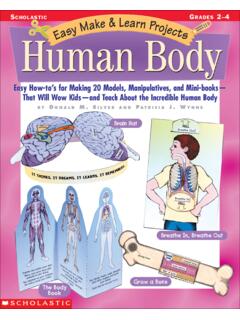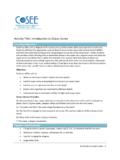Transcription of Teaching About Plate Tectonics and Faulting Using ... - IRIS
1 Foam-faults activity 1 Teaching About Plate Tectonics and Faulting Using Foam ModelsActivity modified from Braile, Purdue University, by Chris Hedeen, Oregon City high school , ORObjective:Demonstrate Plate tectonic principles, Plate boundary interactions and the geometry and relative motions of Faulting of geologic layers Using 3-D foam models. The foam models aid in visualization and understanding of Plate motions and Faulting because the models are three-dimen-sional, concrete rather than abstract descriptions or diagrams, can be manipulated by the instructor and the students, and the models can show the motions of the plates and faults through time in addition to the three-dimensional configuration of the plates or layers. The fault and Plate bound-ary models shown here illustrate relatively simple motions and geologic structures. Although these models are accurate representations of real Earth Faulting and Plate tectonic structures and motions, the spherical shape of the Earth and the complex-ity of geological features caused by varying rock types and rock properties and geological develop-ment over many millions or hundreds of millions of years, result in significant complexity and vari-ability of actual fault systems and Plate tectonic :Pre-made foam block models (open cell, foam mattress type) blocks shown in Figure 1 AFelt pens (permanent marker, red and black) Manila folders or thin poster board Rubber cement Closed cell foam ( sleeping bag pads, camping equipment) as shown in Figures 3 and 5 Pins Open cell foam as shown in Figure 3A Styrofoam core poster board, cm (1/4 in) thick, as shown in Figure 3 BRazor blade knife Metric ruler Student work sheets begin on Page 6 Teacher answers begin on Page 15 EXTRA.
2 Watch Video Lecture demo & animations: Videos > Fault Models and: Animations > FaultsProcedures:Prepare foam block models as shown in Figure 1A. Cardboard (cut from manila folders or thin poster board) attached to both faces of the fault plane allows the blocks to slip easily along the fault as forces are applied to the blocks. Glue manila-folder paper to the faces of the fault planes so the blocks slip easily during extension and 1A. Foam block model 2 Foam-faults activity Types of Faulting and Plate Boundaries1) Normal Faulting (Extension)Use the block models to demonstrate normal Faulting as the two outer blocks are moved apart as shown in Figure 1B. This procedure is best performed by holding the blocks in the air in front of you, supporting the model by the two outer blocks, rather than on a table. Note that as the two outer blocks are moved apart, the inner block drops downward or subsides.
3 This relationship between extensional motion of geologic layers and downdropped fault blocks (graben or rift valley if the downdropped block is bounded on both sides by normal faults, as in this block model) produces normal Faulting . It also represents the extensional motion and resultant rift development as-sociated with divergent Plate boundaries (Table 1). Examples of divergent Plate boundaries, where extensional Faulting is prominent, are the mid-ocean ridge system in which a narrow rift or graben (downdropped fault block) is commonly observed along the highest part of the ridge and the East African Rift in which extension has been occurring in the continental lithosphere for About 30 million years and the resulting rift system of normal faults is beginning to break apart the continent. In a Plate - tectonic -related, but not Plate boundary environment, the Basin and Range area of the Western United States displays a prominent topographic signature of extensional Faulting with many adjacent downdropped fault blocks or grabens and the topographic high areas between the grabens are called horsts Figure 1B.
4 Normal Faulting Using the foam model. Red arrows represent extension. Half-arrows along faults show direction of relative motion along the fault plane. 2) Reverse (Thrust) Faulting (Compression)To demonstrate compressional motion and resulting reverse (also called thrust) faults hold the foam block models as described above and then move the two outer blocks together as in Figure 1C. The inner block will be thrust upwards producing reverse faults and an uplifted block. In a Plate tectonic setting, such compressional motion is associated with convergent Plate boundaries (Table 1) where two lithospheric plates are moving together or col-liding (see also section 3 below). Not surprisingly, these convergent zones are associated with mountain ranges (Himalayas, Alps, Andes, etc.). Figure 1C. Reverse Faulting Using the foam model. Red arrows represent compression. Half-arrows along faults show direction of relative motion along the fault plane.
5 Foam-faults activity 33) Strike-slip or Horizontal slip fault motion (Shear)To demonstrate horizontal slip or strike-slip fault motion, prepare foam blocks as shown in Figure 1D. Moving the blocks horizontally on a tabletop, as shown in Figure 1E, demonstrates strike-slip or horizontal slip fault motion. This motion along a Plate boundary is also called transform (Table 1). The San Andreas Fault zone is a system of strike-slip faults that form the transform Plate boundary at the western edge of the North American Plate . Transform faults also occur as oceanic fracture zones be-tween segments of the mid-ocean ridge spread-ing zones Table 1: Faults, Plate Boundaries and Relative MotionsRelative Motion of Layers or Plates Fault Names Plate Boundary Descrip-tions Related tectonic and Geologic Fea-turesExtensionNormalDivergent (extensional, moving apart, spreading, construction - because new lithosphere is gener-ated in the extended zone)Rifts, grabens, sometimes volcanism, regional uplift but local downdropped fault blocks, shallow earthquakesCompressionReverse or ThrustConvergent (compression-al, collision, subduction, moving together, destruc-tive - because one Plate is often thrust into the mantle beneath the other Plate )Folded mountain ranges, uplift, reverse faults, volcanic arcs (usually andes-itic composite volcanoes), deep ocean trenches, shallow and deep earth-quakes in subducted slabTranslation or horizontal slipStrike-slipTransform (horizontal slip, translation)
6 Linear topographic features, offset stream channels, lakes in eroded fault zone, pull-apart basins and local uplifts along fault bends or steps between offset fault segments, oceanic fracture zones, offsets of mid-ocean ridgesFigure 1D and 1E. Strike-slip Faulting Using the foam model. Red arrows represent shearing. Half-arrows along faults show direction of relative motion along the fault plane. Note: This does not require the building of a second model as suggested here. This motion can be modeled by looking at the top of the foam block model used above. Coloring in a feature to be offset such as a road or river shows the lateral offset of strike-slip Faulting . 4 Foam-faults activity Transform or Strike-Slip Plate Boundaries and Elastic ReboundUse a razor-blade knife to make the foam Plate mod-els shown in Figure 2. The foam is cm (1/2 ) thick closed-cell foam often used for sleeping pads for camp-ing. It is available at camping supply stores and Wal-Mart and Target.
7 The foam pieces can be used on a tabletop or on an overhead projector (the slits cut in the foam allow the 10 cm long tabs which bend to be seen projected onto a screen). By continuously sliding the two plates past each other with the tab edges touching (Figure 5), the foam pieces represent lithospheric plates and the zone where the plates touch is a strike-slip (transform) fault. Note that as the plates move slowly with respect to each other (just as Earth s lithospheric plates move at speeds of centimeters per year), the area of the plates adjacent to the fault (the tabs) becomes progressively bent (deformed), storing elas-tic energy. As the process continues, some parts of the fault zone will slip releasing some of the stored elastic energy. This slip occurs when the stored elastic energy (bending of the tabs) results in a force along the fault which exceeds the frictional strength of the tabs that are in contact. Some-times, only small segments of the fault zone (one or two tabs) will slip, representing a small earthquake.
8 At other times, a larger segment of the fault will slip, representing a larger earthquake. Note that although the Plate motions are slow and continuous, the slip along the fault is rapid (in the Earth, taking place in a fraction of a second to a few seconds) and discontinuous. The motions and processes illustrated by the foam model effectively demonstrates the processes which occur in actual fault zones and the concept of the elastic rebound theory (Bolt, 1993). A brief segment during the beginning of the video Earthquake Country illustrates a similar stick-slip motion Using a model made of rubber strips. Figure 2: Foam pieces used to demonstrate strike-slip Faulting , elastic rebound theory, and slipping along the fault plane during earthquakes. Cut out slits with razor blade knife and activity 5 Extensions, Connections, Enrichment: Good preparatory lessons for these activities are studies 1. of elasticity (a spring and masses can be used to dem-onstrate the two fundamental characteristics of elastic-ity - the stretching is proportional to the force (sus-pended mass) and the existence of the restoring force (elastic energy is stored) in that the spring returns to its original length as the force (mass) is removed), and seismic waves which are generated as the fault stick-slip process is well illustrated in a segment 2.
9 Of the NOVA video Killer Quake in which USGS geophysicist Dr. Ross Stein demonstrates this process Using a brick which is pulled over a rough surface (sandpaper) Using an elastic cord (bungy cord). An experiment Using this same procedure is described in Seismic Sleuths (AGU/FEMA).Additional information on Plate Tectonics is available 3. in Bolt (1993), Ernst (1991), Simkin et al. (1994), the TASA CD Plate Tectonics , This Dynamic Earth, and nearly any secondary school or college level geol-ogy textbook. Elastic rebound is well illustrated in Lutgens and Tarbuck (1996), Bolt (1993) and the TASA CD. A color map of the Earth s plates is available on the Internet at: An excellent description of Plate tecton-ics can be found at: additional Plate tectonic activity is the EPIcenter 4. lesson plan Voyage Through Time - A Plate Tectonics flip book in which continental drift during the past 190 million years - a consequence of Plate Tectonics - is effectively illustrated; and Plate Puzzle which uses the This Dynamic Planet Plate tectonic activities, especially for 5.
10 Younger students, are contained in Tremor Troop (NSTA/FEMA).A leading theory explaining 6. why the Earth s plates move is convection currents in the Earth s mantle. The interior structure of the Earth is described in Bolt (1993) and is the subject of the EPIcenter activity Earth s Interior Structure. Good activities illustrating convection are contained in the GEMs guide Convec-tion - A Current Event (Gould, 1988), or Tremor Troop (NSTA/FEMA). References: Bolt, , Earthquakes and Geological Discovery, Scientific American Library, Freeman, New York, 229 pp., , , Earth s Interior Structure - ~braile/ Braile, and Braile, Voyage Through Time - A Plate Tectonics flip book - ~braile/ Braile, and Braile, Plate Puzzle ~braile/ Ernst, , The Dynamic Planet, Columbia University Press, New York, 281 pp., , Seismic Sleuths - Earthquakes - A Teach-ers Package on Earthquakes for Grades 7-12, American Geophysical Union, Washington, , 367 pp.



